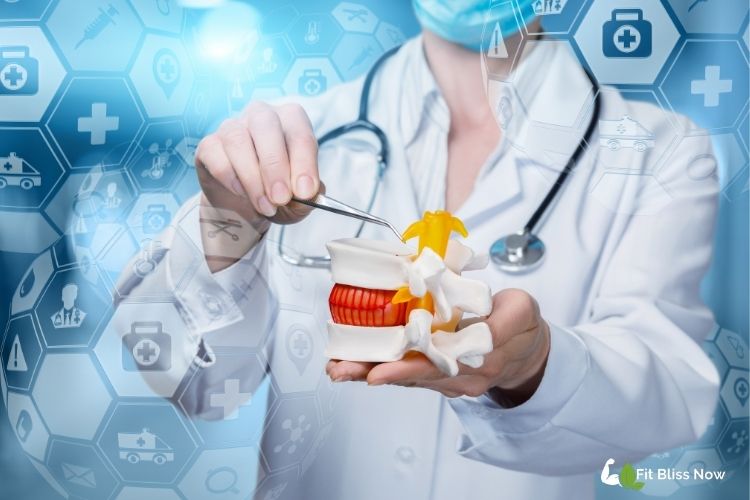A herniated disc causes symptoms such as pain in the lower back, hips, and legs, numbness or tingling in the legs and feet, and weakness in the muscles that rely on support from the lower back. Pain tends to worsen with movements like bending forward, coughing, sneezing, heavy lifting, and prolonged sitting.
The root cause of these symptoms is the compression of nerve roots due to tears, ruptures, or wear and tear in the rubbery cushions (discs) located between the bones that make up the spine.
What Is a Herniated Disc?
A herniated disc occurs when the round cushions, called discs, located between the vertebrae in the spine, are torn or ruptured due to strain or wear and tear, causing nerve root compression. Herniated discs are considered one of the main causes of neck, arm, back, or leg pain. This condition can affect nearby nerves where the herniation occurs, leading to pain, numbness, loss of sensation, and weakness in the limbs.
Although a herniated disc can occur anywhere along the spine, it most commonly affects the lower back or neck. Herniation in the mid-back is relatively rare. It is more prevalent among individuals aged 30 to 50 and is known to affect men more often than women.
Structurally, the spine consists of a series of bones (vertebrae) that extend from the base of the skull to the tailbone. Between these vertebrae are round cushions called discs, which act as shock absorbers, allowing smooth movement and flexibility. Over time, these discs can become damaged, lose their cushioning effect, and shift out of place. When this happens, it is referred to as a herniated disc, commonly known as a slipped or ruptured disc.
The primary cause of a herniated disc is often heavy lifting, but it can also be triggered by other factors such as obesity, sudden movements, aging, prolonged sitting in the same position, and smoking. The tearing, displacement, or rupture of the cartilage between the vertebrae can lead to a herniated disc, which frequently manifests as back pain and mobility issues.

What Is a Herniated Disc?
What Causes a Herniated Disc?
A herniated disc, also known as a lumbar disc herniation, occurs when the cartilage tissue between the vertebrae becomes torn, ruptured, or displaced due to wear and tear or strain, resulting in the compression of nerve roots. Discs act as shock absorbers, providing flexibility to the spine and cushioning between the vertebrae.
Common causes of herniated discs include prolonged sitting in the same position, excessive weight, heavy lifting, sudden movements, and aging, all of which contribute to disc damage.
Normally, the disc is positioned close to the nerve roots, but when it shifts or ruptures, it can press against these nerves. This pressure can lead to symptoms such as lower back pain, leg pain, numbness in the legs, and muscle weakness. The majority of herniated discs occur in the last two lumbar vertebrae.
Here are some common causes of herniated discs:
1. Prolonged Sitting in the Same Position
Those who work desk jobs often remain in the same seated position for extended periods. Over time, this can cause wear and tear on the vertebrae, increasing pressure on the spine and leading to disc herniation. To reduce this risk, even in desk jobs, it’s essential to move frequently and not neglect physical activity.
2. Excessive Weight
Individuals with obesity place significant stress and wear on their spinal system. This pressure can cause the cartilage tissue between the vertebrae to wear out, tear, or displace, leading to herniation. Maintaining a healthy diet and losing excess weight can significantly reduce the risk of herniated discs.
3. Heavy Lifting
Lifting heavy objects is generally unhealthy for the body and muscles. In the case of a herniated disc, heavy lifting can damage the structure of the spine and increase the risk of herniation. Although the effects may not be immediate, repeated heavy lifting can lead to herniation over time.
4. Repetitive Bending or Twisting

What Is a Herniated Disc?
Individuals who frequently bend or twist their bodies are at greater risk of developing herniated discs over time. These repetitive movements can damage the spinal structure, create pressure, and lead to wear and tear. This highlights the importance of minimizing repetitive bending and twisting motions.
5. Aging
As people age, muscles weaken, and the natural structure of the discs deteriorates. This deterioration increases the risk of herniation and the likelihood of developing a herniated disc. To counteract this, older individuals should maintain a healthy diet, exercise regularly, and avoid activities that put excessive strain on the back.
6. Smoking
Smoking reduces blood flow to the discs, which can impair their health over time and increase the risk of herniation. In addition to causing herniated discs, smoking has numerous other well-documented negative effects on health.
7. Poor Posture
Finally, poor posture, especially when it becomes a chronic issue, can also contribute to herniated discs. Maintaining proper posture, such as sitting upright, standing tall, and walking with good alignment, is essential for spinal health and reducing the risk of disc herniation.
What Are the Symptoms of a Herniated Disc?

What Is a Herniated Disc?
A herniated disc can cause a range of symptoms, including pain radiating from the lower back to the hips, legs, and feet, as well as tingling, numbness, and weakness in the affected muscles. These symptoms often worsen during activities like movement, coughing, sneezing, or prolonged sitting or standing.
Common Symptoms of a Herniated Disc:
- Pain in the lower back, neck, or shoulder blades
- Pain in the hips or legs if the sciatic nerve is compressed
- Numbness or tingling in limbs, particularly in areas served by the affected nerve
- Pain behind the calf or in the soles of the feet
- Difficulty with bending or straightening the back
- Muscle weakness or reduced strength in affected areas
- Pain that intensifies at night, after sitting or standing for a long time, or during coughing or sneezing
In severe cases, symptoms such as loss of sensation in the inner thighs, back of the legs, or around the rectal area, along with progressive muscle weakness and difficulties in urination or bowel movements, may require immediate medical attention.
Detailed Breakdown of Symptoms:
1. Pain in the Lower Back, Neck, or Shoulder Blades
Herniated discs often result in pain, numbness, or tingling sensations due to nerve compression in the spinal region. Pain may radiate down to other areas, depending on the location of the herniation.
2. Hip or Leg Pain
A specific symptom of lumbar disc herniation is sciatic pain that radiates from the lower back to the leg, potentially extending to the soles of the feet. This is often referred to as sciatica.
3. Numbness or Tingling in Affected Areas
The compression of nerves near the herniated disc can lead to numbness, tingling, or a “pins and needles” sensation in parts of the body served by these nerves.
4. Weakness in Muscles
Nerves compressed by a herniated disc may affect the muscles they control, leading to symptoms such as stumbling, difficulty lifting or holding objects, or challenges with actions like raising the leg or standing on tiptoes.
5. Difficulty with Back Movements
Activities that require bending or straightening the back, such as standing up from a bent position, can become difficult and painful due to increased pressure on the herniated disc and surrounding nerves.
6. Worsening Pain During Coughing or Long Periods of Sitting/Standing
Movements like coughing, sneezing, or sitting for extended periods exert pressure on the herniated disc, intensifying the pain. Additionally, prolonged lack of movement, such as during sleep, can exacerbate symptoms by triggering inflammation or muscle spasms.
7. Muscle Spasms in the Back
Herniated discs can cause severe pain and spasms in the lower back muscles, often accompanied by leg cramps.
8. Changes in Bladder or Bowel Function
In severe cases, herniated discs may compress the nerves controlling the bladder and bowel, leading to incontinence or loss of control. A herniation at the L4-L5 disc level can also cause sexual dysfunction.



